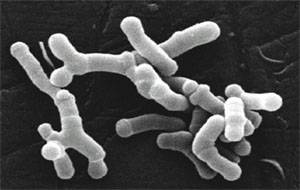 The eye has a normal community of microbes or eye microbiome, just like other body sites (i.e., the gut, the sinuses, the mouth). This community of bacteria is thought to offer resistance from invaders (such as pathogenic bacteria).
The eye has a normal community of microbes or eye microbiome, just like other body sites (i.e., the gut, the sinuses, the mouth). This community of bacteria is thought to offer resistance from invaders (such as pathogenic bacteria).
The researchers of a recent study found differences in the eye microbiome of contact lens wearers as compared to non-lens wearers. The results indicate that wearing contact lenses "alters the microbial structure of the ocular conjunctiva, making it more similar to that of the skin microbiota" (the community of microbes living on the skin).
Further research is needed to determine whether these differences in the eye microbiome in contact lens wearers is the reason why contact lens wearers develop more eye conditions and infections (such as giant papillary conjunctivitis and keratitis). Over 30 million Americans wear contact lenses so these are important issues.
From Science Daily: Contact lenses alter eye bacteria, making it more skin-like
Contact lenses may alter the natural microbial community of the eyes, according to a study published this week in mBio®, an online open-access journal of the American Society for Microbiology. In a study of 58 adults seeking outpatient eye care, researchers at New York University School of Medicine found that contact lenses make the eye microbiome more skin-like, with higher proportions of the skin bacteria Pseudomonas, Acinetobacter, Methylobacterium, and Lactobacillus and lower proportions of Haemophilus, Streptococcus, Staphylococcus, and Corynebacterium.
It's unclear how these changes occur, said senior study author Maria Dominguez-Bello, PhD, an associate professor of medicine at the university, "if these bacteria are transferred from the fingers to the lens and to the eye surface, or if the lenses exert selective pressures on the eye bacterial community in favor of skin bacteria." Wearing contact lenses has been identified as a risk factor for the development of eye infections such as giant papillary conjunctivitis and keratitis, "so these questions are important," she said.
Researchers used a laboratory technique called 16s rRNA sequencing to compare the bacterial communities of the conjunctiva (the eye surface) and the skin under the eye from 58 adults. They also analyzed samples from 20 of the study participants (9 lens wearers and 11 non-lens wearers) at three time points over the course of six weeks....researchers found a higher diversity of bacteria on the ocular surface than on the skin under the eye or on the contact lenses, which was a surprising result, Dominguez-Bello said.
The ocular surface microbiota of those who wore contact lenses was more skin-like compared to those who did not wear lenses. It was enriched in the bacteria Pseudomonas, Acinetobacter, Methylobacterium, and Lactobacillus. In non-lens wearers, these bacteria were detected at a higher relative abundance in skin samples compared to the eye (except for Lactobacillus), suggesting that these bacteria could be classified as skin bacteria. The bacteria Haemophilus, Streptococcus, Staphylococcus, and Corynebacterium were depleted in the ocular microbiota of lens wearers compared to non-lens wearers.

 The possibility of giving microbes in the future (whether bacteria, viruses, or fungi) to treat cancer is amazing. Of course big pharma is pursuing this line of research, which is called immunotherapy (stimulating the body's ability to fight tumors). The Bloomberg Business article discusses a number of big pharma companies entering the field and their main focus. The study in the journal Science finding that giving common beneficial bacteria (Bifidobacterium breve and Bifidobacterium longum) to mice to slow down melanoma tumor growth is a first step. The researchers themselves said that the 2 common beneficial bacteria species exhibited anti-tumor activity in the mice and was as effective as an immunotherapy in controlling the growth of skin cancer. But note that the bacteria needed to be live. Stay tuned....
The possibility of giving microbes in the future (whether bacteria, viruses, or fungi) to treat cancer is amazing. Of course big pharma is pursuing this line of research, which is called immunotherapy (stimulating the body's ability to fight tumors). The Bloomberg Business article discusses a number of big pharma companies entering the field and their main focus. The study in the journal Science finding that giving common beneficial bacteria (Bifidobacterium breve and Bifidobacterium longum) to mice to slow down melanoma tumor growth is a first step. The researchers themselves said that the 2 common beneficial bacteria species exhibited anti-tumor activity in the mice and was as effective as an immunotherapy in controlling the growth of skin cancer. But note that the bacteria needed to be live. Stay tuned.... Makes sense that not driving to work in a car, but using mass transit (public transport), cycling, or walking to work results in lower body mass index (BMI) and body fat. They're moving more! From Science Daily:
Makes sense that not driving to work in a car, but using mass transit (public transport), cycling, or walking to work results in lower body mass index (BMI) and body fat. They're moving more! From Science Daily: A thought-provoking
A thought-provoking  Another study showing that higher physical activity (from a variety of activities) is "related to larger gray matter volume in the elderly, regardless of cognitive status", specifically in gray matter areas of the brain responsible for memory, learning, and cognition. In other words, higher levels of physical activity reduce brain atrophy that occurs with aging and improves cognitive function in elderly individuals. There is also discussion of higher activity levels improving cerebral (brain) blood flow. Bottom line: get off your butt and move more for better brain health. From Medical Xpress:
Another study showing that higher physical activity (from a variety of activities) is "related to larger gray matter volume in the elderly, regardless of cognitive status", specifically in gray matter areas of the brain responsible for memory, learning, and cognition. In other words, higher levels of physical activity reduce brain atrophy that occurs with aging and improves cognitive function in elderly individuals. There is also discussion of higher activity levels improving cerebral (brain) blood flow. Bottom line: get off your butt and move more for better brain health. From Medical Xpress: Not good news. More than half of Americans’ calories come from “ultra-processed foods,” according to
Not good news. More than half of Americans’ calories come from “ultra-processed foods,” according to  Yes, the chemicals in personal care products and cosmetics you use absolutely get into your body, have effects, and can be measured in the urine. Of especially big concern are the endocrine (hormone) disrupting chemicals such as phthalates, parabens, triclosan, and oxybenzone (BP-3). This study shows that even taking a 3 day break from these chemicals lowers their levels in your body. The researchers found that : "The adolescent girls in this study experienced an average within girl decline of 27-45% in urinary concentrations of certain phthalates, certain parabens, triclosan, and oxybenzone after three days of abstaining from conventional personal care products and using replacement products with labels indicating they did not contain these chemicals."
Yes, the chemicals in personal care products and cosmetics you use absolutely get into your body, have effects, and can be measured in the urine. Of especially big concern are the endocrine (hormone) disrupting chemicals such as phthalates, parabens, triclosan, and oxybenzone (BP-3). This study shows that even taking a 3 day break from these chemicals lowers their levels in your body. The researchers found that : "The adolescent girls in this study experienced an average within girl decline of 27-45% in urinary concentrations of certain phthalates, certain parabens, triclosan, and oxybenzone after three days of abstaining from conventional personal care products and using replacement products with labels indicating they did not contain these chemicals." Two recent studies link low vitamin D levels with more aggressive cancers: aggressive prostate cancer in men and more aggressive breast cancers (in mice and women). Researchers generally advise people to take 1000 to 2000 international units per day of vitamin D3 to maintain normal blood levels of of more than 30 nanograms/milliliter. The best source of vitamin D is sunlight, which is why vitamin D is frequently called the sunshine vitamin.
Two recent studies link low vitamin D levels with more aggressive cancers: aggressive prostate cancer in men and more aggressive breast cancers (in mice and women). Researchers generally advise people to take 1000 to 2000 international units per day of vitamin D3 to maintain normal blood levels of of more than 30 nanograms/milliliter. The best source of vitamin D is sunlight, which is why vitamin D is frequently called the sunshine vitamin.